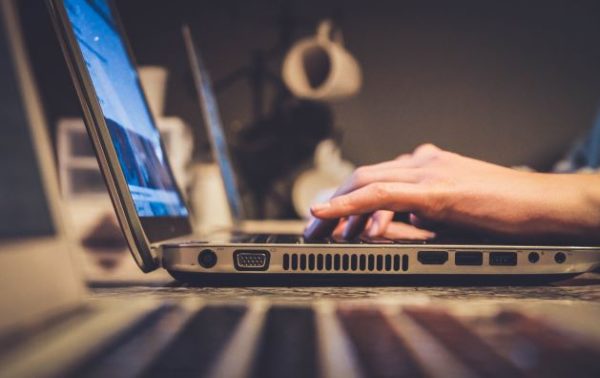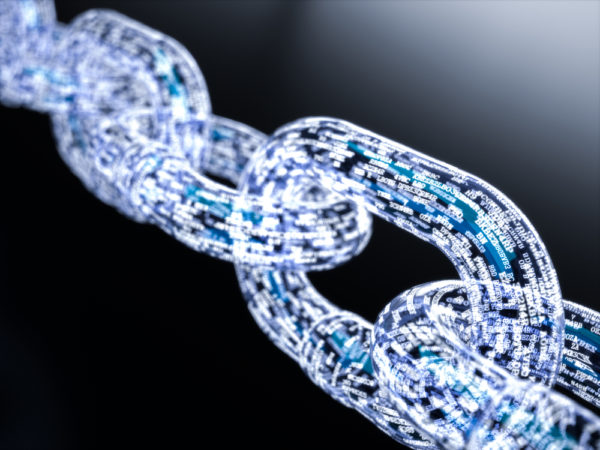The Most Popular Fakes In The World
Written by Ramsay Monime | April 22, 2022
Counterfeit products are everywhere. From the tacky, replica football jerseys you find on holiday to pristine copies of handbags, shoes and watches that are near-impossible to tell apart from the real thing.
In fact, research by the OECD suggests the counterfeit product industry is worth a staggering USD 464 billion (GBP 356 billion) each year. Furthermore, nearly 2 in 10 people in the UK admit to buying fakes due to the economic saving, as the most fashionable items typically come with hefty price tags.
But what counterfeit versions of brands and products are people most interested in buying?
To find out, we’ve gathered the data and crunched the numbers in a bid to name the most popular counterfeit brand in the world.
We decided to focus on three product categories:
- Footwear, e.g. Nike
- Luxury designers, e.g. Gucci
- Watches, e.g. Rolex
These are the three of the most counterfeited goods globally, by their share of customs seizures and total value.
We then looked at monthly search volume data from Google for search terms like “fake Nike”, “replica Gucci”, and “buy fake Rolex watches” to calculate the number of people looking for counterfeits of the top brands in each category. We could then find the most popular by the total number of searches by ranking each brand by the total number of searches!
So, what did we find?
Kanye West Tops The Charts
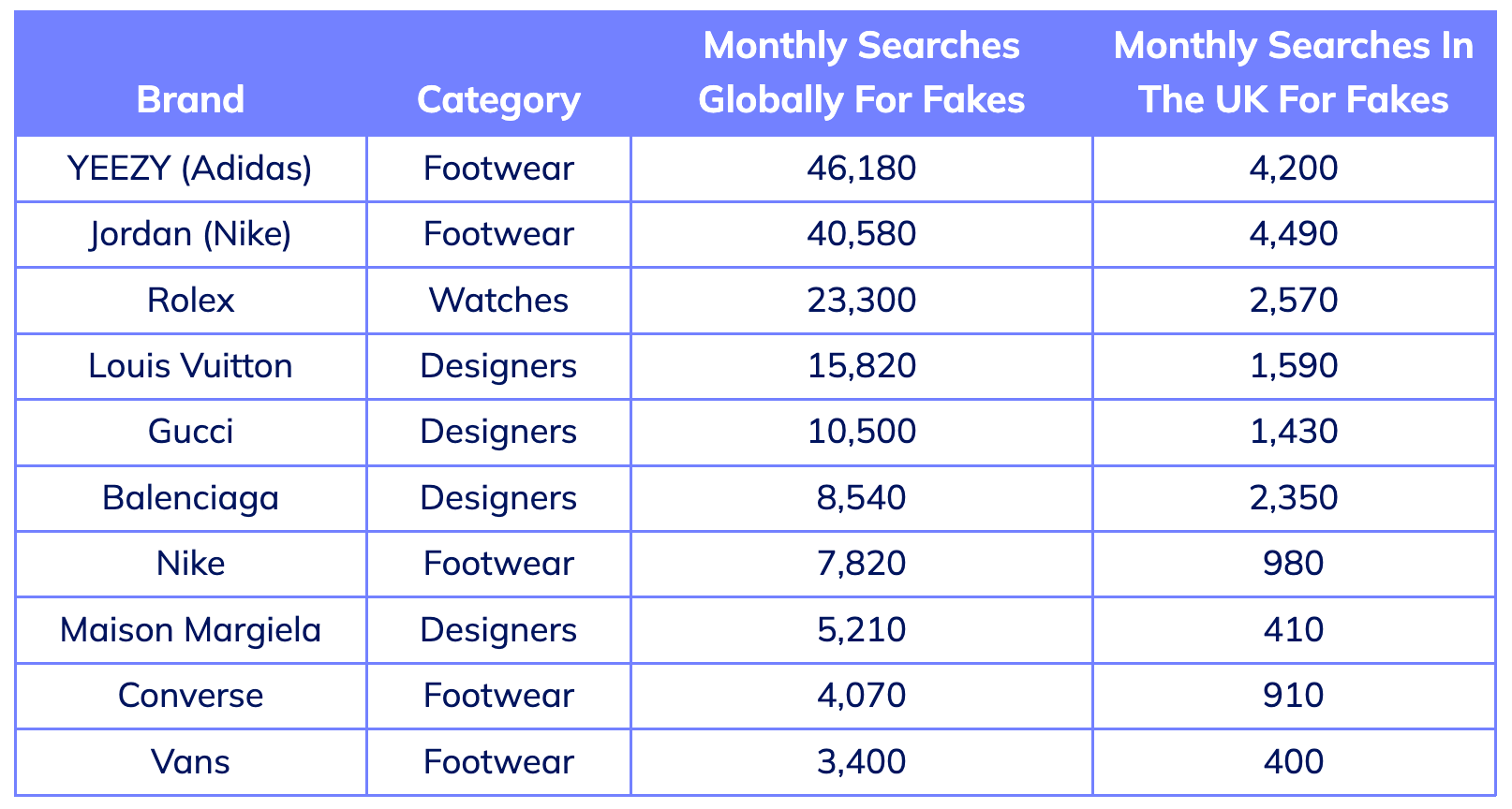
Kanye West’s famed collaboration with Adidas, YEEZY, and Nike’s iconic Air Jordan range (named after basketball legend Michael Jordan and first produced nearly 30 years ago) battle it out for the top spot.
YEEZY just about edges it with an astonishing 46,000 searches for counterfeit versions. Meanwhile, Jordans come in second on 40,000 searches a month.
These are two of the most popular brands on the planet. The clamour for Jordans began nearly 30 years ago when Michael Jordan was establishing himself as one of the greatest and most successful athletes of all time.
By contrast, Kanye West and Adidas first released the YEEZY line in 2015. In just seven years, they’ve become incredibly popular.
But neither is cheap. YEEZY shoes are produced in limited numbers, and they typically sell for hundreds of pounds – with people willing to camp outside stores the night before a release to get their hands (or should that be ‘feet’?) on a pair. The limited runs mean that resales are thriving, too, with specific pairs going for thousands on the second market.
Jordan’s aren’t quite as expensive, but they still usually sell for north of £100.
And it’s this mix of limited availability (especially for YEEZY’s) and high retail price that drives people towards fakes.
Footwear is the most in-demand product category
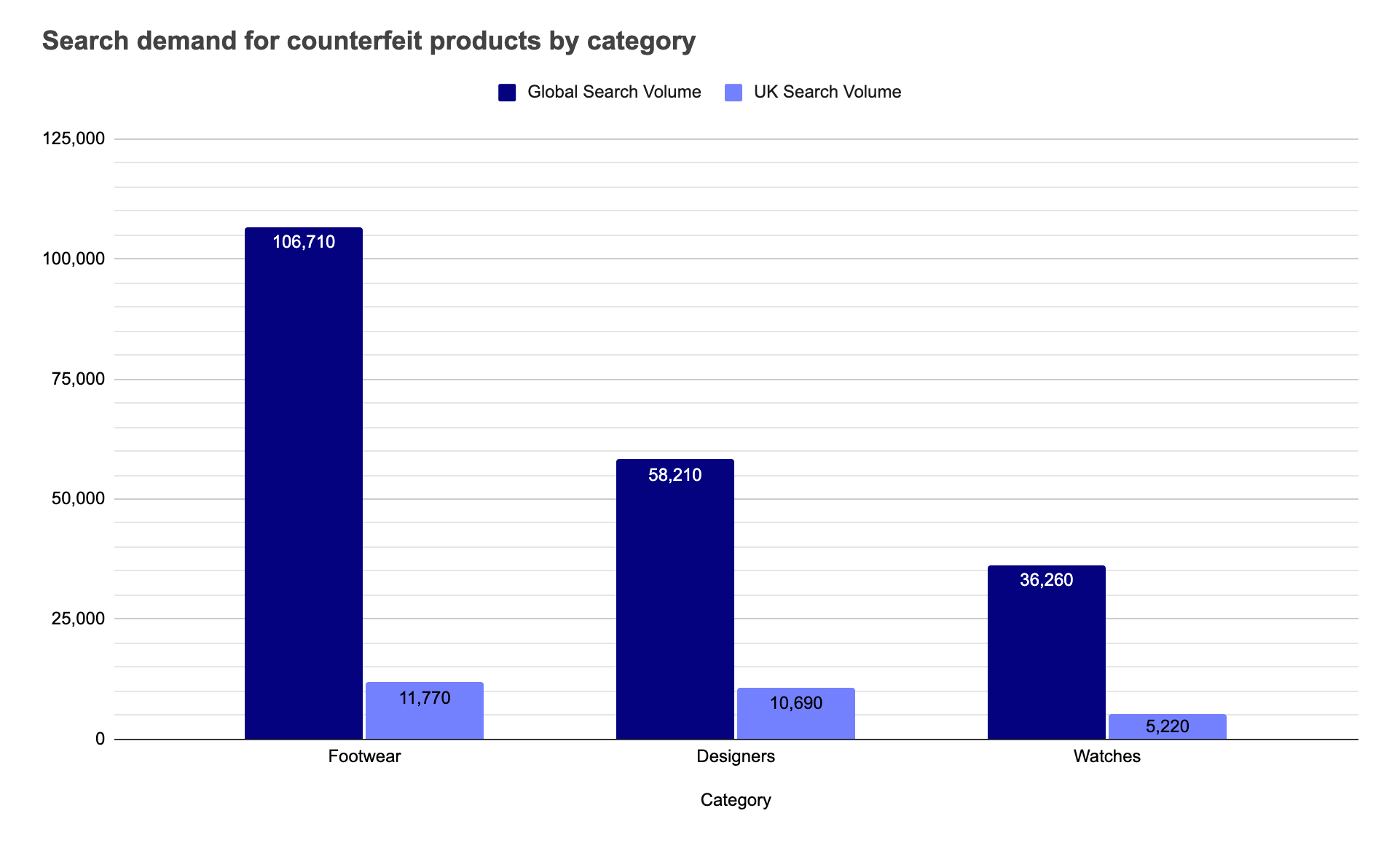
Searches for fake footwear brands are by far the most popular.
This is mainly due to the dominance of YEEZY and Jordan. Fake versions are searched for over 86,000 times a month globally, pushing the footwear category into 1st place.
Breaking it down by product category
Footwear
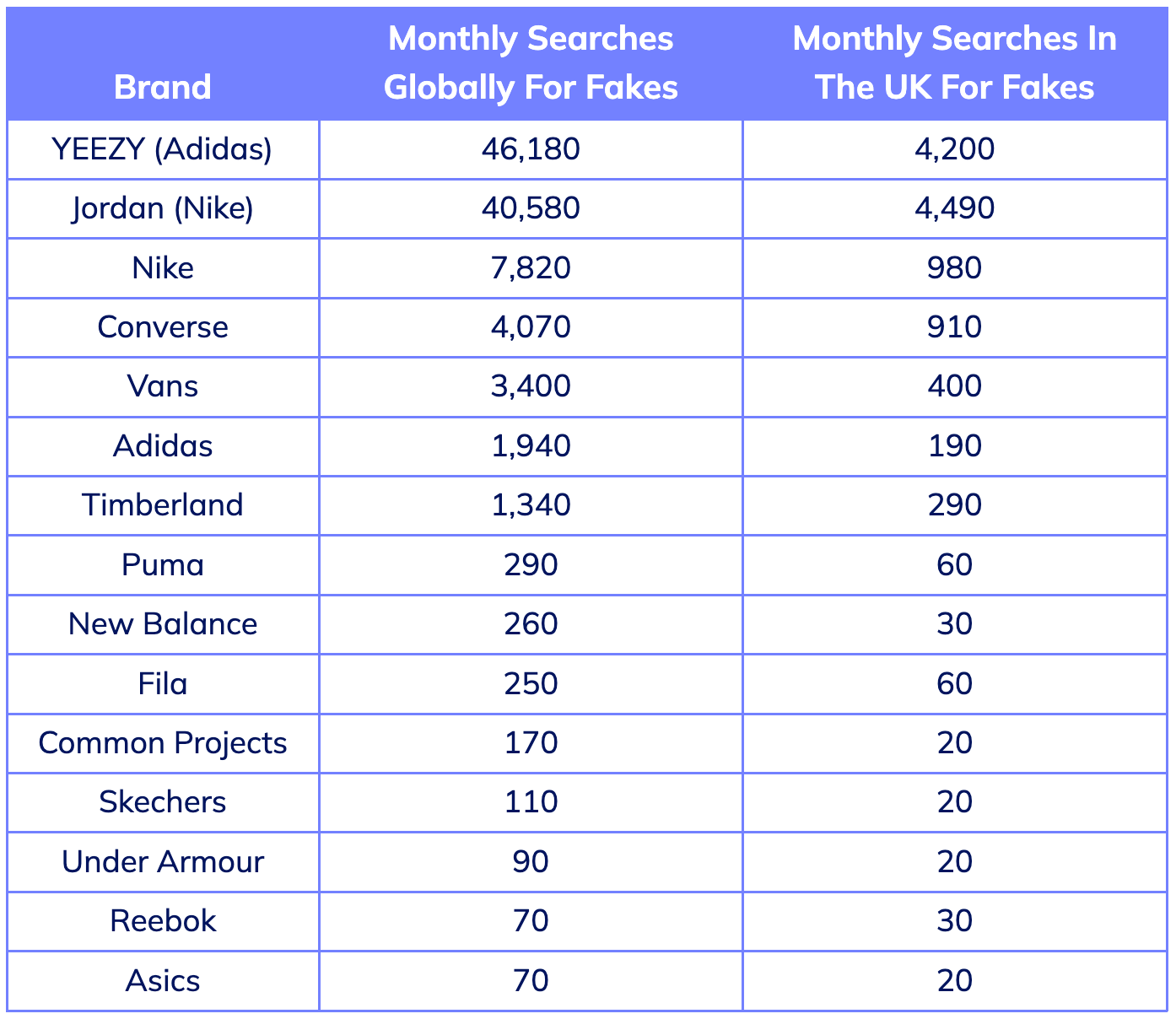
When we look solely at footwear brands (no pun intended), we see a significant drop in interest for counterfeit versions after YEEZY and Jordans.
Interest in counterfeit versions of Nikes is still substantial. Beyond Jordan’s, Nike has many in-demand models, including Air Force 1’s, Air Max’s and Dunks. In fact, previous research has shown Nike is the most popular shoe brand in the world, so it’s no surprise to see this translate across to a high level of interest in counterfeits too.
Designers
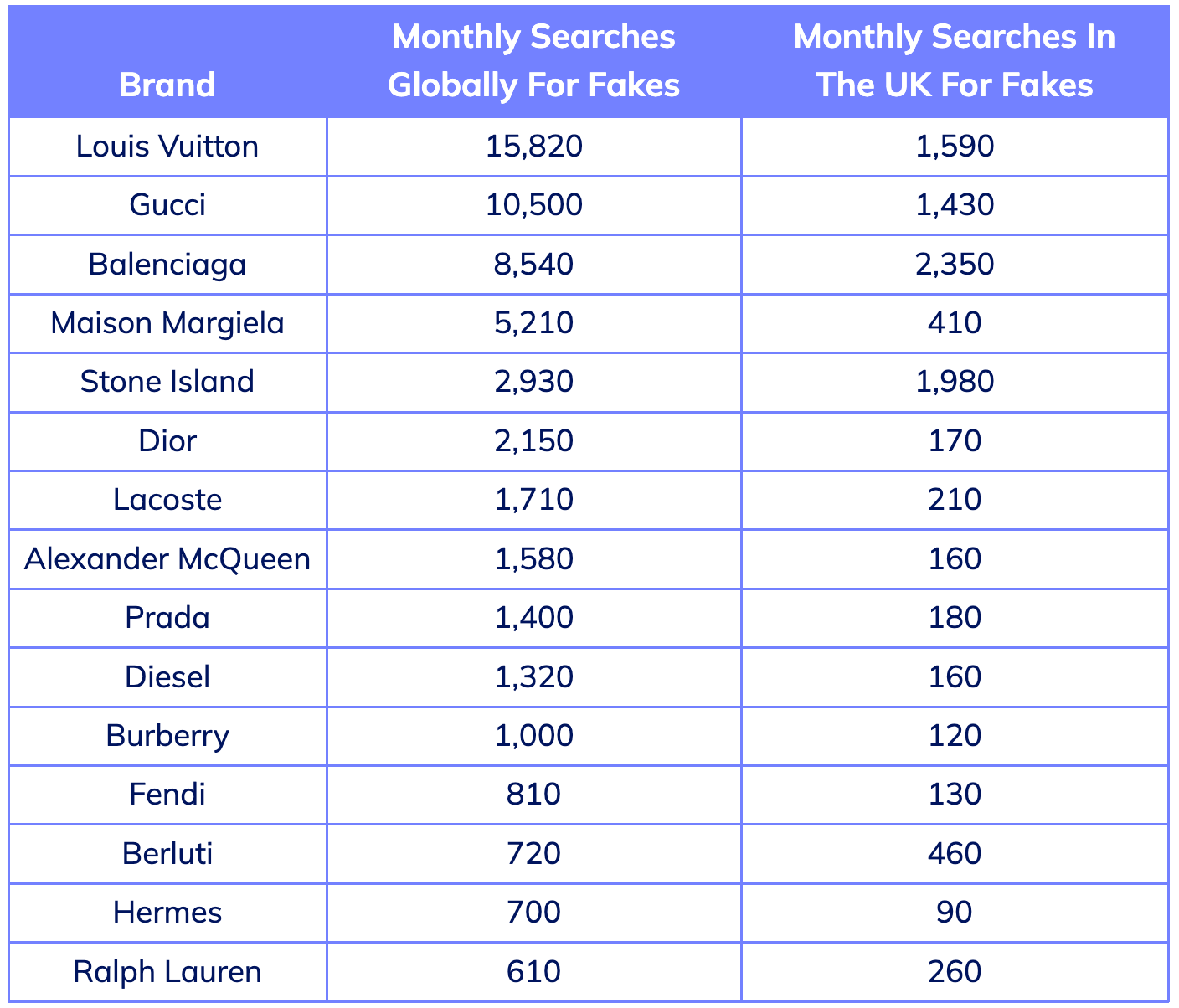
Louis Vuitton takes the top spot in the designer category, with nearly 16,000 searches globally each month. Founded in 1854, the French fashion house has since become synonymous with luxury goods, in particular through its iconic range of bags.
Interestingly, demand for counterfeits in this category is much more evenly spread than in the footwear and watch product categories.
This makes sense. Firstly, many of these brands offer a wide range of products (including footwear and watches), opening them to a broader scope of counterfeiting.
Secondly, they’re some of the oldest, most recognisable names in the world. Owning items by Louis Vuitton, Gucci, Balenciaga, and any designer label, has long since become a statement of wealth and social status simply through the name or logo printed on the item. Yet, with prohibitive price tags for the actual products, a counterfeit can serve the same purpose for the wearer at a more accessible cost.
Watches
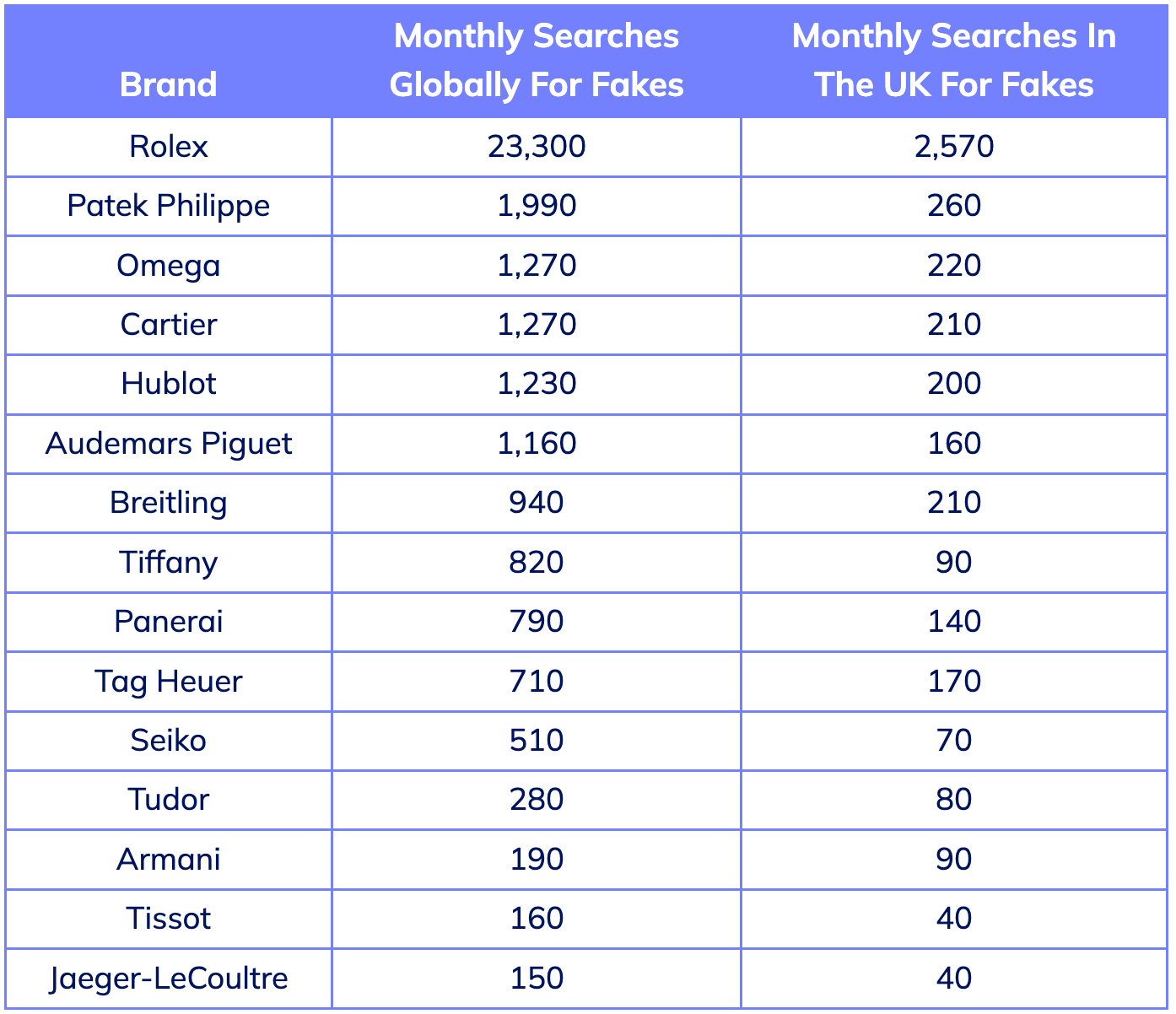
Counterfeit Rolex watches are, by far, the most popular within this category. On average, over 23,000 people each month search for a fake Rolex.
The Swiss brand was founded in Britain in 1905 before moving operations to Geneva after the First World War. Rolex routinely tops the list amongst the watch industry for spending on advertising and marketing, which has helped to establish its watches in popular culture through celebrity ambassadors, film placements (James Bond, Apocalypse Now and Titanic, to name a few), and music (does anyone remember Wearing My Rolex by Wiley?).
Naturally, this has resulted in widespread demand for their timepieces. But, with price tags that only a minority can afford, there is now a vast underground economy for counterfeits.
No other watch brand comes close to the demand for a fake Rolex, which (weirdly) suggests their high-spending marketing strategy has worked well. Or, you could argue other watch brands are doing a better job of advertising only to audiences that can afford to buy the real thing, leading to lower interest in counterfeits.
The problem with counterfeits
If there’s one thing this research has shown, it’s that the general public routinely seeks out counterfeit versions of their favourite brands to save money.
It’s hard to blame the buyer. There’s a societal pressure to wear the latest and most fashionable items, but most people cannot afford real versions, especially with recent squeezes on living standards.
The blame, of course, lies with the producers, importers, and sellers of counterfeit products, who infringe on the intellectual property rights of leading brands by leveraging their popularity for profit.
There are several ways this can impact a company:
- Harms revenue, with counterfeit versions undercutting the market
- Damages their hard-earned reputation
- Requires lots of time, resources and budget to fight against
Plus, consumers often don’t realise there are potentially harmful risks attached to buying counterfeits:
- Cybersecurity – Do you trust an online seller of counterfeits to keep your details, including credit/debit card numbers, safe? Can you trust they won’t be hacked or, worse still, sell your details to people with malicious intentions?
- No fraud protection – If you buy a counterfeit online and it doesn’t arrive, there’s no way to get your money back.
- Safety – Counterfeit products may not be made to the same health and safety standards as the originals.
- Organised crime – Buying counterfeits funds organised crime groups, which may result in harm to others.
What can companies do to stop counterfeits?
Whilst we’ve only looked at the biggest fashion brands in the world in this research, counterfeits can affect a wide range of companies. So what can a company do to stop counterfeits?
As a firm specialising in intellectual property (IP) law, we’ve helped many businesses with this issue. We recommend taking the following steps:
- Register: Ensure your brand names are registered as trade marks and that the shapes of new products are registered as registered design rights. From experience, we find it is easier (and cheaper) to rely on registered IP rights against counterfeiters as subsistence (i.e. that the brand or product is protected by an IP right) does not need to be proven.
- Think internationally: Counterfeiting is often a cross-border problem, so it’s important to consider where you are having the issue and ensure you have appropriate IP protection in that territory.
- Target the big ones first: Identify the major counterfeiters and make an example of them by using legal tools such as cease and desist letters. We find that going after a big market player, smaller operators often decide to stop because they have heard about the bigger player getting into trouble with the brand owner.
- Customs notices: File customs notices with the relevant customs authorities. Customs have the power to seize counterfeit goods that enter their territory, meaning counterfeit items can be seized at airports, shipping ports and borders. Naturally, this reduces the number of counterfeit items in the marketplace.
- Move fast: We often find that more counterfeiters enter the marketplace if brand owners do nothing. Conversely, if a brand owner acts quickly, there will be fewer counterfeiters in the market. Plus, the fact there are fewer counterfeiters serves as a deterrent to others, as it signifies the brand owner is actively enforcing its intellectual property.
So there you have it, a look into the murky world of counterfeit products and intellectual property. If you’d like to learn more or speak to the Briffa team about counterfeits, please contact me directly at ramsay@briffa.com or the wider team at either info@briffa.com or +44 020 7096 2779.
